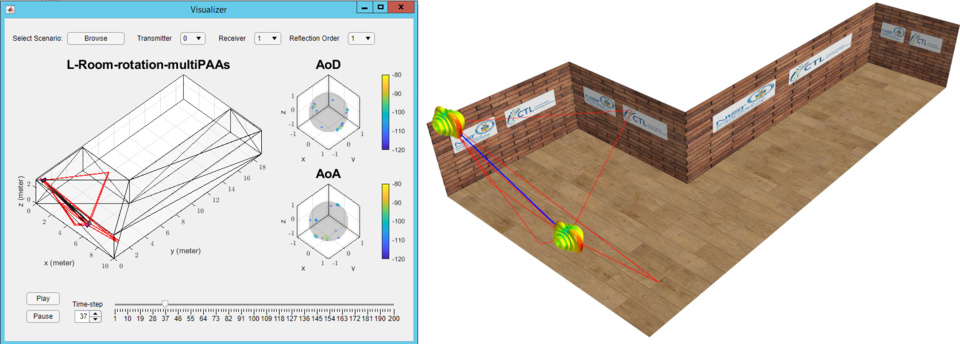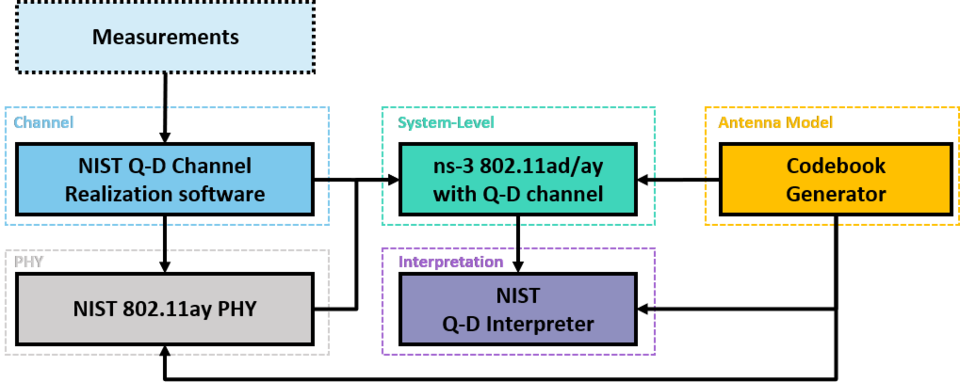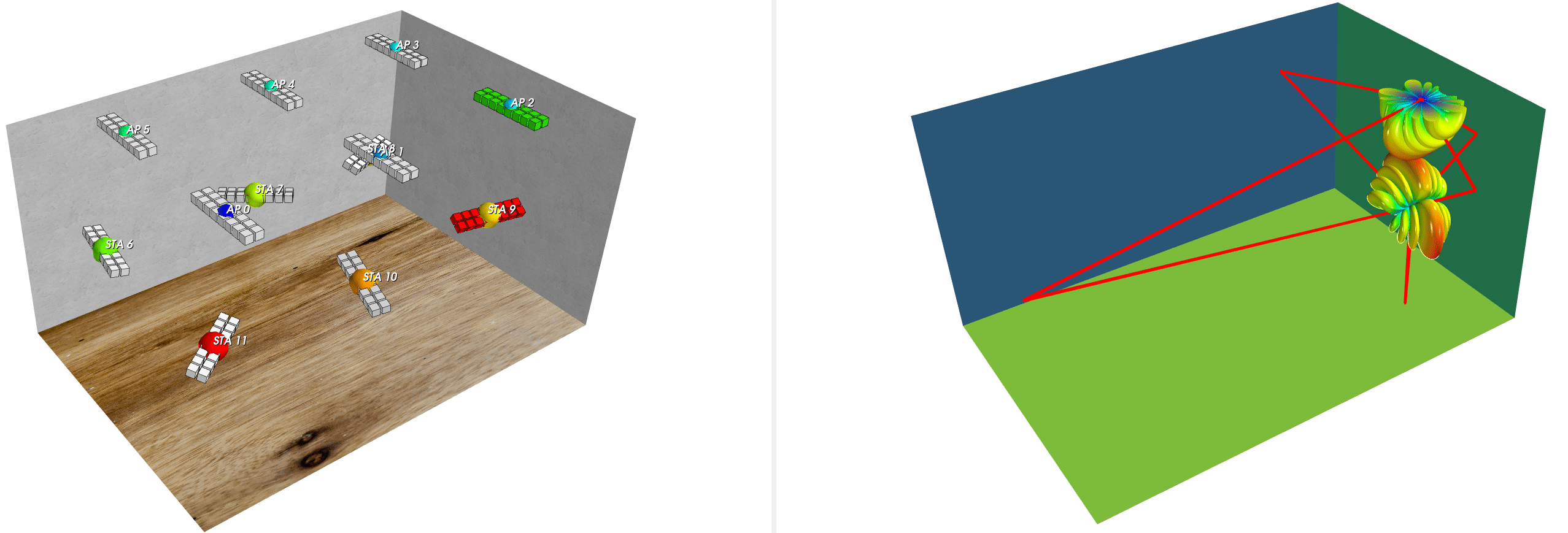Summary
5G and beyond communications will include several technical advancements that enable innovative applications such as wireless backhauling, Augmented/Virtual Reality (AR/VR), 8K video streaming and sensing. This project is focused on system-level insights and performance analyses of emerging wireless protocols and standards. Our goal is to use measurement-based models for wireless propagation in the design, the development and the evaluation of next generation wireless communications systems. We work with industry and the research community to improve the accuracy and availability of system-level modeling tools dedicated for such purposes.
Description
Millimeter wave Communication Systems and Protocols
5G and beyond wireless communication systems make use of the Millimeter-Wave (mmWave) band. While this band offers unprecedented throughput thanks to the large bandwidth available, it also suffers from larger propagation loss compared to the sub-6 Ghz band. This characteristic imposes a complete rethinking of the traditional communication paradigm, i.e., omni-directionality. Indeed, to guarantee adequate received signal power, mmWave systems employ directional beams formed by antenna arrays, i.e., beamforming. Beamforming focuses the power (both in transmission and in reception) towards the chosen direction by properly steering the antenna elements of the antenna array.
The directionality of the communication poses a number of new challenges, including :
-
Beamforming requires to select (Beamforming Training) and adapt (Beamforming Tracking) the directional beams to use between two nodes that are willing to communicate. Beamforming Training and Tracking is of paramount importance for mmWave communications as it drives the performance of the communication links. The initial approach, introduced in IEEE 802.11ad and 3GPP release 15, has been to perform an exhaustive search among all the possible beams combinations. However, there are obvious scalability issues with this approach, especially in the context of MIMO systems. Therefore more efficient beamforming Training/Tracking algorithms are needed.
-
Most wireless and application protocols have been designed with omnidirectional communications in mind. on the other hand, highly directional communications will impose drastic changes on radio-resource allocation schemes in order to take full-benefits of the directionality of the communication.
-
The usage of multiple antennas to compensate for the high propagation loss, enables the PHY to exploit spatial multiplexing techniques to achieve even greater throughput. The design of MIMO precoding and equalization algorithms requires channel estimation techniques tailored to the mmWave propagation characteristics.
A realistic platform that accurately characterizes the propagation environment is vital to evaluate and develop efficient beamforming, radio-resource allocation and channel estimation algorithms and models, as well as antenna array systems that will address these challenges. Until now, research and development has been conducted separately using tools and platforms that are not integrated and generally not compatible. This presents a major impediment to the development and deployment of future generation millimeter wave systems. Our response is to develop a realistic platform that includes accurate characterization of the channel propagation environment: The Quasi-Deterministic (Q-D) Framework.
Quasi-Deterministic (Q-D) Framework

While the development of standard specifications for IEEE 802.11ad/ay is complete, innovative research using IEEE 802.11ad/ay devices is still challenging due to the prohibitive cost of test-bed equipment and the lack of open-source and flexible platforms. The NIST Q-D framework aims to overcome some of these challenges by providing researchers in the mmWave community a set of high-fidelity tools to evaluate and better understand the inter-workings of the IEEE 802.11ad/ay protocols.
Evaluating performance end-to-end often requires the following:
-
An accurate representation of the channel model at 60 GHz.
-
A flexible and high-fidelity antenna model.
-
PHY model and digital baseband transceiver PHY abstractions.
-
A system-level simulator that implements the MAC and PHY specifications of IEEE 802.11ad/ay and that includes realistic channel models, antenna models, and PHY layer abstractions.

To this end, we developed in collaboration with IMDEA and the University of Padova five different open-source tools as displayed in Figure 1.
-
The NIST Q-D Channel Realization Software1: This Matlab tool implements the channel between nodes/antennas pairs in the network using ray tracing and Q-D methodology (link). The channel is described through the Multi-Path Components (MPCs) properties such as number of MPCs, path loss, delay, angles of arrival and departures. User can define its own 3D environment and nodes mobility/rotations. This software includes a visualizer to display the generated MPCs between each pair of nodes.
-
The Codebook Generator2: This Matlab tool generates Phased Antenna Arrays properties such as steering vectors and Antenna Weight Vectors based on user-defined Phased Antenna Arrays characteristics (geometry, number of elements, etc.).
-
The Integrated Sensing and Communication Physical Layer Model3: This tool is a Matlab implementation enabling baseband link-level simulation of millimeter-wave (mm-wave) wireless communication and sensing systems. ISAC-PLM models the Physical Layer (PHY) of IEEE 802.11ay, including a growing set of features, such as Multi-User Multiple-Input Multiple-Output (MU-MIMO) link level simulation, IEEE 802.11ay single carrier (SC)/orthogonal frequency-division multiplexing (OFDM) waveform generation, synchronization, channel estimation, carrier frequency offset (CFO) estimation and correction. It provides an end-to-end simulation platform, including transmitter and receiver, importing the channel realized by the Q-D Channel Realization Software.
The software allows to compute several metrics, such as bit error rate, packet error rate, target range and target velocity estimation accuracy.
It can be used to export lookup tables of packet error rate varying SNR, in AWGN or mm-wave channel, for different modulation and coding schemes. -
The ns-3 802.11ad/ay with Q-D channel implementation4: The ns-3 system-level simulator has been modified to include IEEE 802.11ad/ay functionalities. Our implementation imports the channel realized by the NIST Q-D Channel Realization Software, the antenna characteristics produced by the Codebook Generator, and includes the PHY layer abstraction by the NIST 802.11ay PHY to obtain high-fidelity system-level evaluation.
-
The NIST Q-D Interpreter3: IEEE 802.11ad/ay system-level performance highly depends from the beamforming applied at the transmitter/receiver side. To help interpretation of the beamforming training results, we developed a python 3D visualizer that takes as an input the beamforming results obtained in ns-3 and displays the antenna patterns for a transmitter/receiver communication.

____________________________________________________________________
- Developed by NIST in collaboration with University of Padova SIGNET Group
- Developed by IMDEA WNG Group
- Developed by NIST
- Developed by IMDEA WNG Group in collaboration with NIST
Integrated Communication and Sensing Systems
Sensing and communication systems are competing technologies, sharing the same spectrum and using similar hardware components. The idea of Integrated Sensing And Communication (ISAC) systems has recently gained the attention of research and standardizations communities. Co-designing sensing and communication systems allows to efficiently re-use the spectrum and the hardware resources, for example reusing the communication waveforms and devices to enable sensing applications. For this reason, integrated communication and sensing has been identified as an enabling technology for 5G/6G, and the next-generation Wi-Fi system.
The ubiquitous presence of WiFi devices in our everyday life offers a unique opportunity to enable innovative applications such as presence detection, gesture recognition, or person identification, re-using existing WiFi devices. IEEE has recently (September 2020) started a new task group, TGbf, to extend the current IEEE 802.11ay high throughput functionalities, with cm-level sensing resolution.
IEEE 802.11bf envisions to enable sensing for a wide range of applications such as gesture recognition, number of persons in a room, breathing activity, etc. The requirements for these applications can be vastly different, e.g., detect an object proximity requires less amount of information and accuracy compared to detect a person and identify its pose.
The design of integrated communication and sensing systems poses several challenges including:
- Resource allocation: The sensing accuracy performance will be strongly dependent on the availability and update frequency of the channel measurements. However, as IEEE 802.11bf re-uses the communication link, sending and exchanging sensing information can be solely seen as an overhead from a WiFi performance point-of-view, reducing throughput and increasing latency. In this case, the larger the overhead, the better the sensing accuracy will be at the cost of a lower transmission data rate.
- Cooperation and scheduling: cooperative sensing (CSENS) is foreseen as a key enabler of high-resolution sensing. CSENS will use multiple sensing devices collaborating to capture additional information about the surrounding environment (e.g., in case of blockage between a sensing device and a target, another sensing device could still be able to sense the target). CSENS will also incur additional overhead as it will not only require more entities in the sensing framework but will also raise new challenges such as synchronization between the multiple entities, establishment of a distributed sensing measurements, fusion of partial sensing information, etc.
- Beamforming training at mm-wave: the optimization of the beamforming training to maximize the communication performance creates very narrow beams. The limited field of view does not allow to have sense the entire environment.
The Q-D channel model realization software will be used as a baseline to create the NIST ISAC Channel Realization software by introducing the concept of targets, i.e., person or object to sense. While the NIST ISAC Channel Realization software can support different target models, our current study focus on human targets, which can enable several applications such as presence detection and localization. The human motion is modeled with kinematic models, which approximate the human body as a collection of joints. The NIST 802.11ay PHY is enhanced with dedicated ISAC sensing signal processing to obtain range-doppler information, which allows the detection of moving objects. Finally, the NIST Q-D interpreter is extended to allow the visualization of the interaction between the wireless signal and the human target, while displaying the correspondent range-doppler map.
PUBLICATIONS
Beamforming Training
- M. Kim, T. Ropitault, S. Lee, N. Golmie, H. Assasa, and J. Widmer, "A Link Quality Estimation-based Beamforming Training Protocol for IEEE 802.11 ay MU-MIMO Communications", in IEEE Transactions on Communications, Vol. 69, No. 1, January 2021.
- M. Kim, T. Ropitault, S. Lee and N. Golmie, "Efficient MU-MIMO Beamforming Protocol for IEEE 802.11ay WLANs", in IEEE Communications Letters, Vol. 22, No. 1, January 2019.
- Y. Kim, S. Lee and T. Ropitault, "STS Adaptation for Beamforming Training of Asymmetric Links in IEEE 802.11ay-based Dense Networks", in Proceedings of IEEE Vehicular Technology Conference (VTC Spring 2020), June 2020.
- Y. Kim, S. Lee, and T. Ropitault, "Adaptive Scheduling for Asymmetric Beamforming Training in IEEE 802.11ay-based Environments", in Proceedings of IEEE Wireless Communications and Networking Conference (WCNC 2019), April 2019.
PHY Layer Evaluation
- J. Zhang, S. Blandino, N. Varshney, J. Wang, C. Gentile and N. Golmie, "Multi-User MIMO Enabled Virtual Reality in IEEE 802.11ay WLAN," 2022 IEEE Wireless Communication and Networking Conference.
- A. Bodi, J. Zhang, J. Wang, and C. Gentile, " Physical-Layer Analysis of IEEE 802.11ay using a Channel Fading Model from Mobile Measurements", in IEEE International Conference on Communications (ICC 2019), May 2019.
- N. Varshney, J. Zhang, J. Wang, A. Bodi and N. Golmie, "Link-Level Abstraction of IEEE 802.11ay based on Quasi-Deterministic Channel Model from Measurements," in Proc. of 2020 IEEE Vehicular Technology Conference (VTC2020-Fall), April 2020.
Sensing
- S. Blandino, T. Ropitault, A. Sahoo and N. Golmie, "Tools, Models and Dataset for IEEE 802.11ay CSI-based Sensing," 2022 IEEE Wireless Communication and Networking Conference.
-
T. Ropitault, S. Blandino, N. Varshney and N. Golmie, "Q-D simulation & Modeling framework for sensing", presented at TGbf.
-
S. Blandino, T. Ropitault, N. Varshney and T. Ropitault, "A preliminary channel model using raytracing to detect human presence", presented at TGbf
Hybrid MAC Performance
- C. Pielli, T. Ropitault, N. Golmie, and M. Zorzi, “An analytical model for CBAP allocations in IEEE 802.11ad,” in IEEE Transactions on Communications, vol. 69, no. 1, 2021.
- J. Chakareski, M. Khan, T. Ropitault, and S. Blandino, “6DOF virtual reality dataset and performance evaluation of millimeter wave vs. free-space-optical indoor communications systems for lifelike mobile VR streaming,” in 2020 54th Asilomar Conference on Signals, Systems, and Computers, 2020.
- T. Azzino, T. Ropitault and M. Zorzi, "Scheduling the Data Transmission Interval in IEEE 802.11ad: A Reinforcement Learning Approach," 2020 International Conference on Computing, Networking and Communications (ICNC), May 2020.
- C. Pielli, T. Ropitault, and M. Zorzi "The Potential of mmWaves in Smart Industry: Manufacturing at 60 GHz", in International Conference on Ad-Hoc Networks and Wireless, AdHoc Now 2018, pp. 64-67.
The Q-D framework
- H. Assasa, N. Grosheva, T. Ropitault, S. Blandino, N. Golmie, and J. Widmer, “Implementation and evaluation of a wlan IEEE 802.11ay model in network simulatorns-3,” in Proceedings of the Workshop on Ns-3, WNS3 ’21, (New York, NY, USA), 2021.
- H. Assasa, T. Ropitault, S. Lee and N. Golmie, "Enhancing the ns-3 IEEE 802.11ad Model Fidelity: Beam Codebooks, Multi-Antenna Beamforming Training, and Quasi-Deterministic mmWave Channel", in Workshop on ns-3 (WNS3 2019), June 2019.
- H. Assasa, J. Widmer, J. Wang, T. Ropitault, and N. Golmie, "An Implementation Proposal for IEEE 802.11 ay SU/MU-MIMO Communication in ns-3", in Workshop on Next-Generation Wireless with ns-3 (WNG 2019), June 2019
- H. Assasa, J. Widmer, T. Ropitault, A. Bodi, and N. Golmie, "High Fidelity Simulation of IEEE 802.11 ad in ns-3 Using a Quasi-deterministic Channel Model", in Workshop on Next-Generation Wireless with ns-3 (WNG 2019), June 2019
Ultra-Dense networks
- M. Kim, T. Ropitault, S. Lee and N. Golmie, "A Throughput Study for Channel Bonding in IEEE 802.11ac Networks," in IEEE Communications Letters, vol. 21, no. 12, pp. 2682-2685, Dec. 2017.
- T. Ropitault and N. Golmie, "ETP algorithm: Increasing spatial reuse in wireless LANs dense environment using ETX," 2017 IEEE 28th Annual International Symposium on Personal, Indoor, and Mobile Radio Communications (PIMRC).
- T. Ropitault, "Evaluation of RTOT algorithm: A first implementation of OBSS_PD-based SR method for IEEE 802.11ax," 2018 15th IEEE Annual Consumer Communications & Networking Conference (CCNC)
Major Accomplishments
- Participating in IEEE working groups (TGay, TGbf).
- Over 20 peer-reviewed publications on the evaluation and improvement of IEEE 802.11ax/ad/ay.
- Developed (in collaboration with IMDEA) the first open-source ns-3 IEEE 802.11ay implementation. Main features include MIMO Beamforming Training and Quasi-Deterministic propagation model

